Georgian Fashion: Georgian period is named after the then ruling king of England, King George III. During this period England enjoyed a stable political climate. This was the time when France and England were rivals on the fashion front.
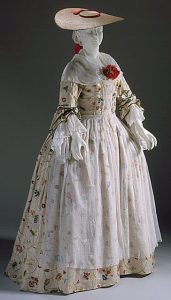
In France, women’s fashion started to change drastically during the revolutionary period. The extravagant corsets, panniers, and silk brocade gowns were replaced by thin, almost transparent Grecian-like cotton dresses.
Georgian Era Dress for Women
The idea of neoclassical simplicity changed the way a female’s appearance was treated. The Georgian era dress began to drape and flow. Corsets were discarded completely and the body was allowed to feel free and remain in its natural shape.
A new style of gown called the chemise gown which was made of thin, flowing cotton usually of white or pastel in color came into the Georgian Fashion. This style was inspired by the European countryside clothing and writings from authors like Rousseau.
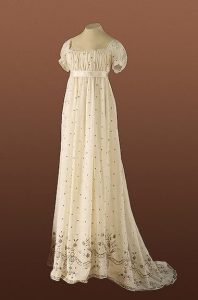
Initially, the chemise gown was considered deemed and immodest, but aristocrats who possessed forward thinking began wearing this style. By 1802, all of fashionable European started wearing the chemise gown in a reformed version. Today, this gown is referred to as the Empire style gown.
The corset made a comeback and gained popularity in 1810 and by 1815 the white, Empire style gown went completely out of fashion in France. However, in England, it remained in fashion.
The early English gowns were slightly different from the French gowns. They were fuller in the skirt width and materials like sheer cotton fabrics like muslin, gauze and percale were popular English gown materials.
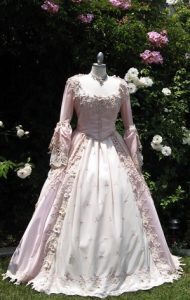
Raw materials were imported from India and America and were manufactured in the textile mills in England. Since the Georgian era costumes or gowns were made of thin material, large shawls were needed during winter to beat the cold weather.
Another defense from cold was the jacket and Spencer jacket was the most popular one which the English tailors fashioned in a short close-fitting jacket. This, however, developed into the full-length coat later on.
Women’s Hair
Women during this period tied their hair in natural styles tying up in loose-fitting buns. Although some women cut their hair short, short hair was not a widely accepted trend those days and women who cut their hair short used to regret their decision soon. Girls above 13 years of age would not wear their hair down.
Hats, bonnets, and turbans were quite essential these days and these were considered to complete a woman’s outfit. Women always wore at least one of these when out in public while at home they used to wear a close-fitting cotton cap to cover their hair.
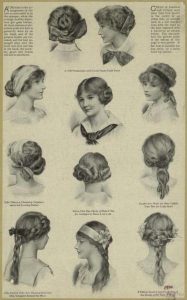
Another Georgian Fashion accessory was the reticule which was a small purse like bag closing with either a drawstring or a metal frame on the top. These were usually made of silk until 1810, but after that velvet and leather were also used to bring in variety to reticules.
Parasols which were slender and light in weight as well as came in different sizes, shapes and color were considered an important Georgian Fashion accessory. It protected a lady’s skin from the sun.
Georgian Fashion
Gloves were also prominent during these days. Ladies used to wear wrist gloves during the day and the ones extended to the elbows for the evening wear.
Fashionable ladies used fans not just to cool themselves, but also to enhance body language and gestures. These fans were usually made of paper or silk on sticks of wood and ivory. They were printed with popular scenes of the era or oriental motifs.
Georgian Era Clothing
The fabric for Georgian era clothing was usually white lawn, batiste or muslin. Muslin was less costly than silk and it also laundered better, but the white muslin needed a great deal of attention to keep them looking pristine white.
Since wearing a white gown was a sign of social status, women usually wore it in the evenings. During the day they wore pastel or colored robes.
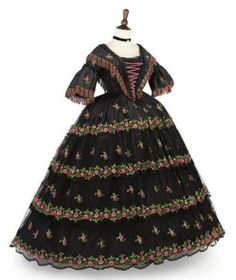
In winter the materials used were cotton, velvets, linen, silk and fine wool. Sometimes extra warmth was provided by full under slip dresses or flannel petticoats.
Men’s Fashion
Lace, embroidery and other embellishments were abandoned during the Georgian era. Cut and tailoring became extremely important as dark, well cut and fitted clothes were considered smarter.
Men usually wore cut away cloth coat which had brass buttons on it and above that was a plain waistcoat matching with the pantaloons. Shirts were usually made of linen and were worn with stocks or wrapped in a cravat.
When in public, men wore hard conical riding hat and hessian riding boots. Great care was taken for the laundering of the cravat which was stiffly starched. It was tied very cautiously as well. The tying included various styles.
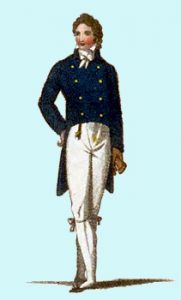
High collared waistcoats were in fashion till 1815. Overcoats or greatcoats were also in fashion during that time. Men started wearing their hair short and curls were in fashion at that time. older men and most of the conservative professionals continued with their wigs and powder.
During the evening, men wore a black coat and silk pantaloons replacing the knee breeches which had begun to be considered old-fashioned. In fact, the dress got simplified and emphasis was laid on tailoring so that the natural form of the body came out.
Children’s Fashion
Children, both, boys and girls wore dress till the age of four or five after which boys were breached and they started wearing trousers.
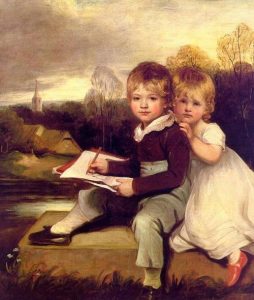
The formal dressing has always been there and has not changed since long. Georgian era is known for its prosperity. The clothing became more person-centric during this era reflecting individual characteristics of the person rather than being a matter of social status.
More Info On- Georgian-Fashion, Victorian Era Designs and Patterns, Victorian Era Gowns